
Thursday, 5 April
“When you wake up in the morning, Pooh,” said Piglet at last, “what's the first thing you say to yourself?” “What's for breakfast?” said Pooh. “What do you say, Piglet?” “I say, I wonder what's going to happen exciting to-day?” said Piglet. Pooh nodded thoughtfully. “It's the same thing,” he said.” Biscuits, gravy and a hard-boiled egg were the (free) exciting breakfast, hands-down the right thing to have south of the Mason-Dixon line, and Clarksdale was the (other) exciting thing that was going to happen. Already a great day.
Clarksdale was one of Robin's more inspired suggestions, though even he could not have predicted just how great a day it would turn out to be. The basic plan: use this as an excuse to take Highway 61, which we rapidly discovered meant we needed to take "Old Highway 61." Use Robin's new reference manuals to see if we could find the gravesite of Memphis Minnie. Then head on down towards Clarksdale, where we would visit the Museum of the Blues. Turning back north we would cut over the Mississippi, so that a) we could say we crossed it, and b) we could drive back to Memphis through Arkansas, thereby bagging another state. Then on to the Germantown Commissary for supper, before ending up at The Cove for the entertainment portion of the day.
Onwards and southwards. We soon found (Old) Highway 61 and with a little more luck than I would have liked, stumbled upon the road we needed to turn off on for the New Hope Baptist Church. Within minutes we had made the prescribed 90 degree bend in the road around some ancient property boundary one assumes, and there was the modern church and in front of it, its much older cemetery. Even as we approached in the van, there was no question which grave we were here to visit "The tallest stone in the cemetery" Robin read. Yes, and the widest and the fattest too.
Rathole: Memphis Minnie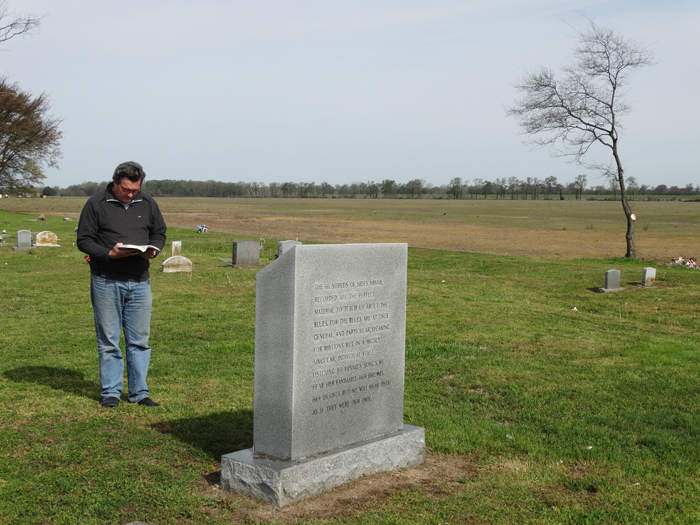 Memphis Minnie died August 6, 1973, aged 76 and is buried at the New Hope Baptist Church Cemetery, in Walls, Mississippi. The headstone added 20 years later was paid for by Bonnie Raitt. The inscription on the back reads: "The hundreds of sides Minnie recorded are the perfect material to teach us about the blues. For the blues are at once general, and particular, speaking for millions, but in a highly singular, individual voice. Listening to Minnie's songs we hear her fantasies, her dreams, her desires, but we will hear them as if they were our own." Minnie continued to record into the 1950s, but her health began to decline. With public interest in her music waning, she retired from her musical career, and in 1957 she returned to Memphis. When she could no longer survive on her Social Security income, various magazines wrote about her plight, and readers sent her money for assistance. She spent her last years in the Jell Nursing Home, in Memphis, where she died of a stroke in 1973. Memphis Minnie has been described as "the most popular female country blues singer of all time". Big Bill Broonzy said that she could "pick a guitar and sing as good as any man I've ever heard." Minnie lived to see a renewed appreciation of her recorded work during the revival of interest in blues music in the 1960s. She was inducted into the Blues Foundation's Hall of Fame in 1980. Minnie was known as a polished professional and an independent woman who knew how to take care of herself. She presented herself to the public as being feminine and ladylike, wearing expensive dresses and jewelry, but she was aggressive when she needed to be and was not shy when it came to fighting. According to the blues musician Johnny Shines, "Any men fool with her she'd go for them right away. She didn't take no foolishness off them. Guitar, pocket knife, pistol, anything she get her hand on she'd use it". According to Homesick James, she chewed tobacco all the time, even while singing or playing the guitar, and always had a cup at hand in case she wanted to spit. Most of the music she made was autobiographical; Minnie expressed a lot of her personal life in music. |
We walked through the little plot—the whole cemetery was maybe an acre, but no more. Robin looked for all the world like a preacher, which in a way he was, as he read snippets from his books trying to enlighten us on the life and influence of the woman we were here to pay homage to. Despite the fact that his flock was entirely ignorant of the woman or her role in history, Robin's little diversion had a quite profound affect on us. We all have very fond memories of this powerful moment, and would not have missed it for the world.
Back on the road, we kept looking for Highway 61 road signs so we could get a good photo, but of course the official road, where those signs are now posted, was not the road we were following, so all we got were crappy little "Old Highway 61" signs. Not the same.

Robin found a reference to a park that would apparently give us a good view of the Mississippi. I tried to explain the hold the river has on the American psychy. We'd already had a glimpse of its size from our hotel. It divides the country into east and west and very nearly splits it in two, starting up near Canada and draining into the Gulf of Mexico—making it the fourth longest river in the world. The trancontinental railroad starts here (at Council Bluffs on the west side of the river across from Omaha, Nebraska). All broadcast call signs in the United States begin with "K" west of the Mississippi River and "W" east of it.
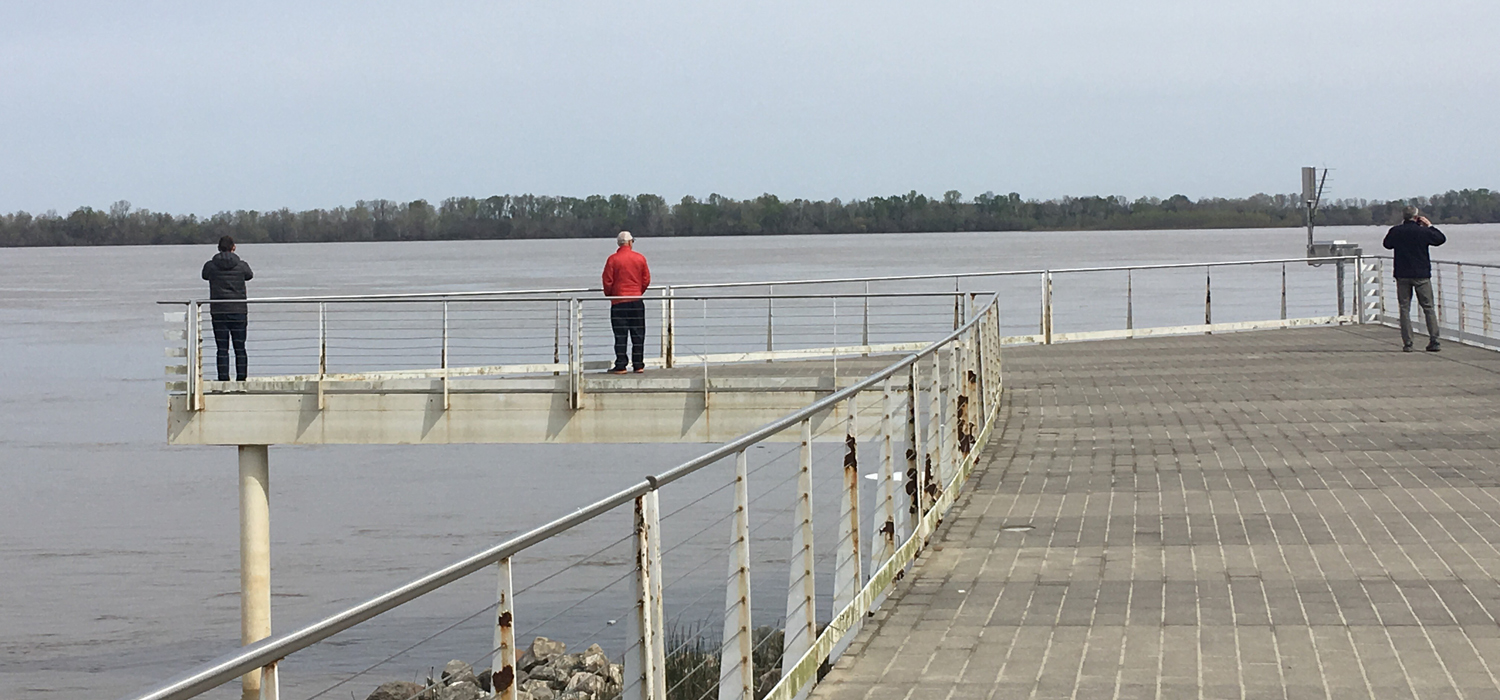
As we headed towards the park, we started seeing signs for casinos and finally the road widened to a divided highway as it went passed a vast complex of eight-story buildings and a million acres of entirely empty parking lots. It was a ghost town. Perhaps shut for the winter, but it looked a lot more desolate than that. When we finally got to the little park it was open, but looked similarly unkempt. But warning signs advising drivers to "turn around or drown" if the road is flooded (really, you couldn't figure that out for yourself?) suggested that indeed this could just be one spring's worth of debris. Nevertheless it was something of a relief to find a couple of other cars in the lot, and better still several trucks with maintenance crews beginning the work. As advertized the river was right there. The idea of drivers heading towards a body of water this large, and even as it washed the tires not burning rubber in reverse if necessary, remains a mystery. An outlook projected out over the water provided a terrific view over and along the river which must have been a good mile across. A splendid photo op, and the rip of the current even at the edge gave us a healthy respect that provided satisfying reinforcement to my earlier lecture.
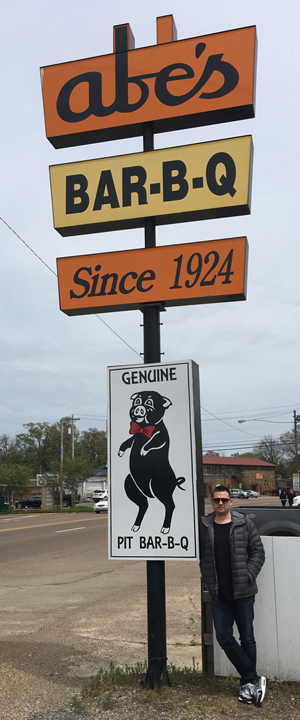
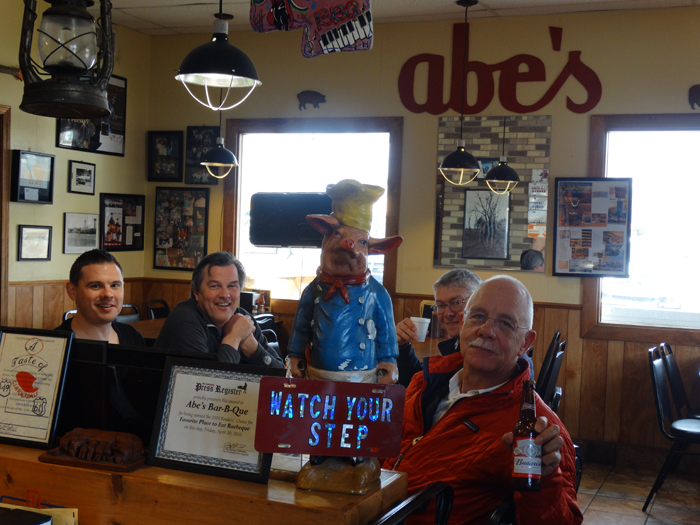
Back in the van, there was a unanimous feeling that we needed to be in Clarksdale, and we needed lunch. As the fields rolled by we tried to guess the crops and convinced ourselves from the stubble that it was probably cotton, though I had somehow imaged it being plucked from perennial bushes rather than grown from scratch each year. John Deere seemed to have pretty much a monopoly on tractors. Even more conspicuously, although the houses and the cars and trucks parked/abandoned near them were as dilapidated as the examples we'd passed in Alabama, the tractors were modern and well-groomed. Several times we saw entire fleets of them parked in open-sided barns.
Clarksdale
Clarksdale, Mississippi has been a center for blues culture since the 1920s. Its location as a transportation hub where Highways 61 and 49 connect, where the Illinois Central and other railroads maintained depots and passenger terminals, and where the Greyhound Bus Company built a station made Clarksdale an economic boom town. Flush times created audiences with money to spend for entertainment, and the blues flourished in the city. Many now-legendary musical artists were born and raised in and around Clarksdale: Muddy Waters, John Lee Hooker, Son House, Ike Turner, Jackie Brenston, Sam Cooke, Junior Parker, and W. C. Handy, among them. Clarksdale was a major market for the Delta’s constantly traveling musicians, and the likes of Robert Johnson, Howlin’ Wolf, and Charley Patton are also associated with the city.
As soon as we hit town we came across Abe's Pit bar-b-q. "That's lunch." I declared, and pulled in. If it really was a real pit bar-b-q, where the chef is on one side of the grill, and you and your plate are on the other, this would be a lunch to remember. It wasn't. It was bar-b-q, and it was a great place, but there was no sign of the chef or the pit/grill. A poster on the wall bragged about their Top 10 placing in a gourmet magazine's bar-b-q sauce competition. It was a perfect occasion to have a beer with my pulled pork sandwich, and it was entirely fitting that the better of the two beer choices was Budweiser so I had my first Bud in 10 years, and recorded the moment in Untappd. The waitress was cute, trying to understand our weird accents, and the locals leaned across the aisle to ask why we were in town and to give us advice on what we should check out in terms of tourist attractions.
The Delta Blues Museum
Maybe. But first we needed to find what we came for: the Delta Blues Museum. The further we drove into town, the crappier and more run-down it seemed to get. By the time we pulled up to the musuem the place felt as desolate as the ghost casino. But the musuem lights were on, the door opened, and there was a lady at the counter ready and willing to take our money.

It was a very nice space, but as I've said before, I'm not really a museum guy, and in this one at least, I figured out why. The reason these people were/are important is not for the clothes and other personal effects on display, but because of the music they made. If I was able to listen to examples of their influences, to hear the progression from the early days to how people like the Rolling Stones who readily admitted to the debt they owed these pioneers, it would have been fascinating. As it was we just had the creaking floorboards of the old depot to listen to.
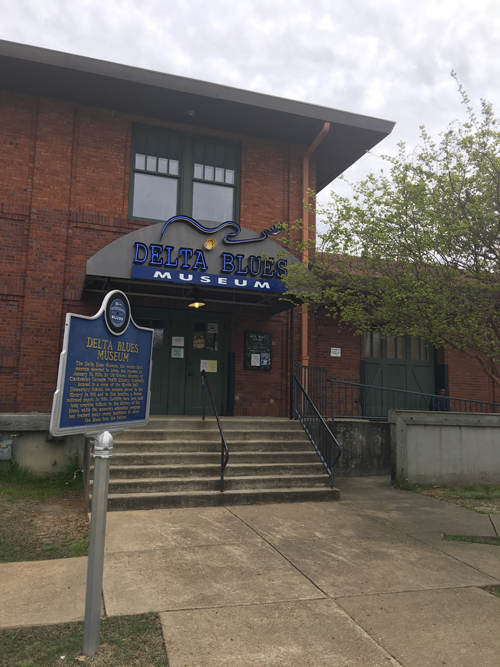 |
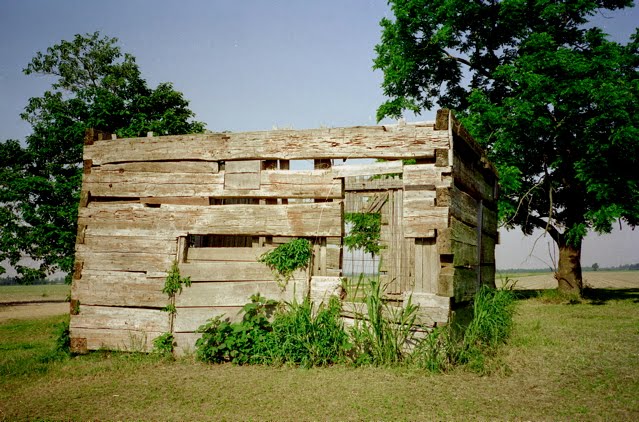
The Delta Blues Museum is dedicated to exploring the history and heritage of the unique American musical art form of the blues. Established in 1979 by the Carnegie Public Library Board of Trustees, the Delta Blues Museum was re-organized as a stand-alone museum in 1999, since when it has been housed in the historic Clarksdale freight depot, built in 1918 for the Yazoo and Mississippi Valley Railroad. |
Still it wasn't without its moments. The remains of the cabin from Stovall Farms where Muddy Waters lived during his days as a sharecropper and tractor driver are currently rebuilt inside the museum, and there was even a small exhibit devoted to Mick and the Boys. A quick tour around the gift shop, where Rob bought a rather cool Blues Musicians Map Poster showing the birth sites of blues musicians throughout the Delta and Mississippi, and we were done.
As we came out there was a guy sitting on the steps having a smoke. He turned to look at us and having sized us up, said "You boys should stop by Ground Zero." "Ground Zero?" "The bar. Just down the street. Look, you can see it from here. It's owned by Morgan Freeman." Having sized us up correctly, and figuring we had some sort of strength in numbers, not that we'd seen anyone, nevermind someone who represented any sort of a threat, we set off in the direction he was pointing. Even when we were right outside it was hard to tell that it was a bar, and even harder to tell if it was open or not. It looked as if it had been shut for years. The sofa on the porch (today's title picture—my hands down favorite for the whole trip) didn't look too dusty, and more tellingly, the smoker seemed to be smoking. We tried the door. It opened.
Ground Zero
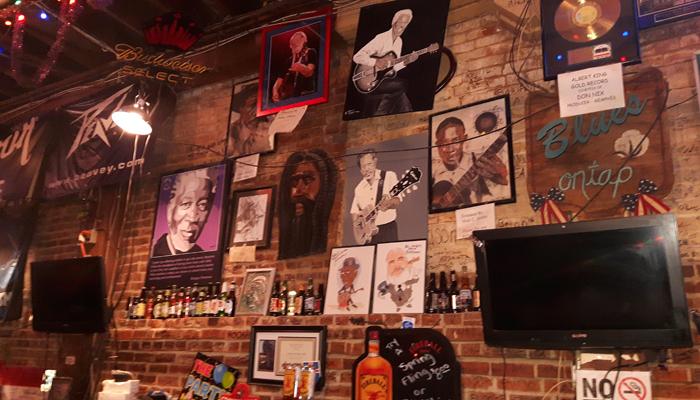
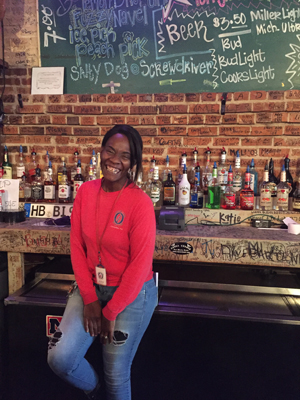
What a cool place. Even though it was empty, we immediately felt at home, and having ordered up some beers starting making plans for when we'd be able to come back and see someone perform at the little stage at the back of the room. Every square inch of the walls had messages, dates, and names scribbled on them with magic marker (Sharpie). Guitars and other memorabilia hung everywhere and Christmas lights completed the grungy decor. I asked the bargal if I could take her picture she got into it so much that everyone started taking her picture. We looked up Ground Zero, Clarksdale on the interweb: #5 on Tripping.com's The 10 Best Blues Clubs in the U.S. for 2018. Damn, we definitely need to come back.
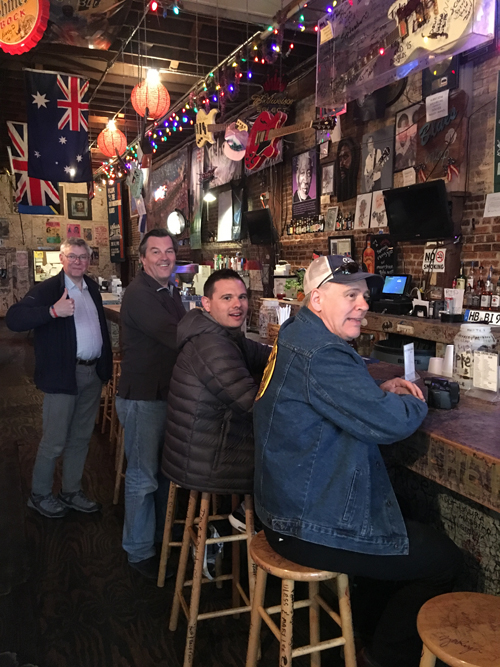 |
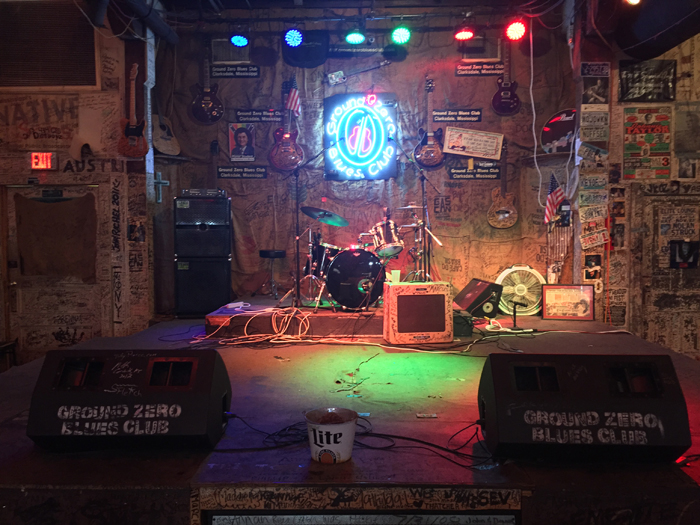 |
Adam and Nick played a game of pool on the table which also had magic marker/Sharpie grafitti and more challengingly a huge rip in the cloth in one corner. I think we could quite happily have spent the rest of the day and night here, but instead, Adam asked if there was a music store in town. He was interested in buying a harmonica. "Why, yes" says our new friend behind the bar. "There's one just up the street." As we were leaving, we asked about the smoker. Sure, it was running. "Take a peek if you like."
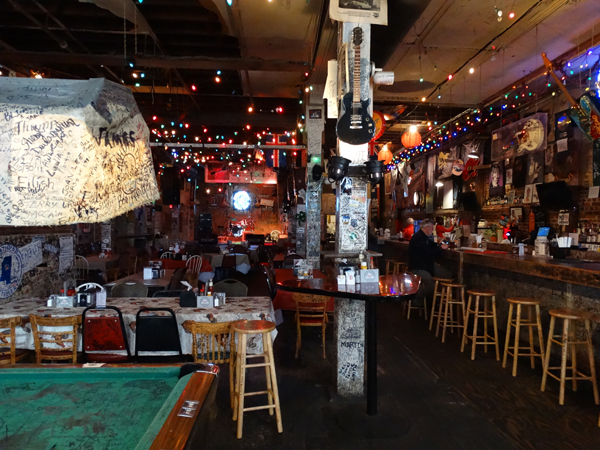 |
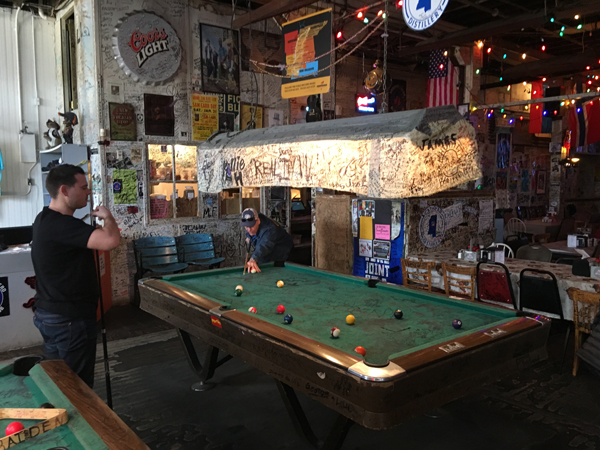 |
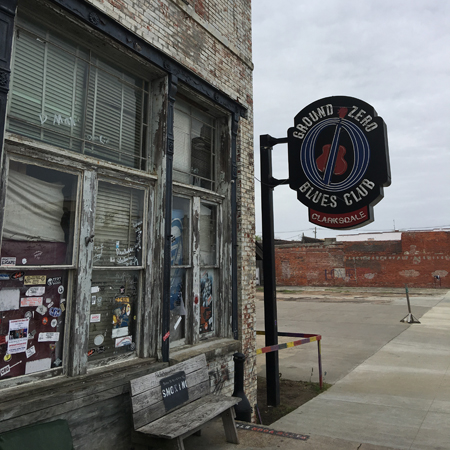 |
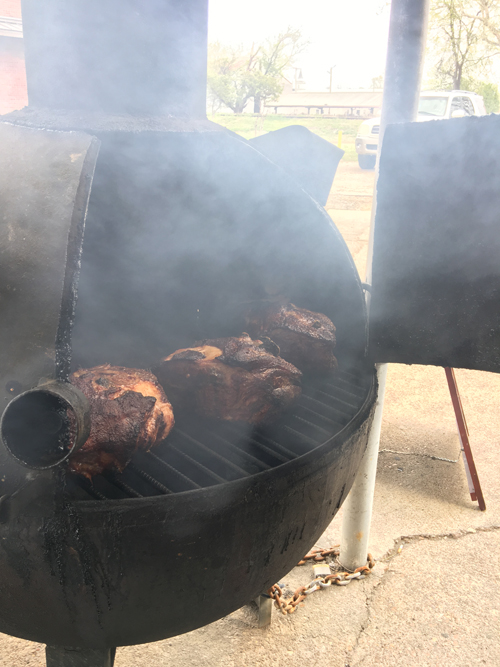
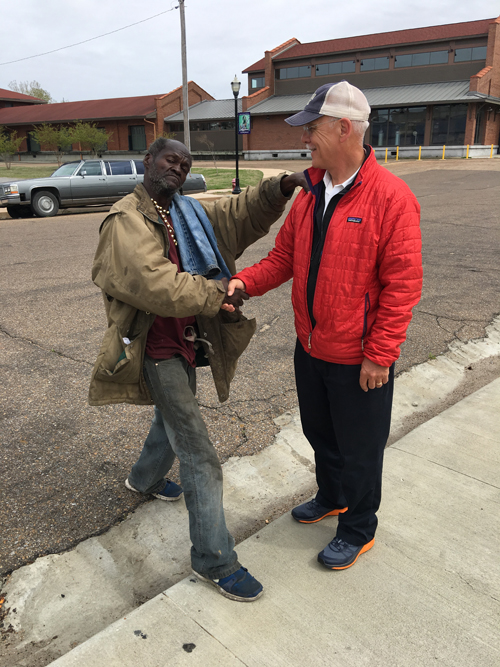
Back on the street, there was now one other person wandering (and I use that term carefully) in our direction. One has to assume he was a denizen of this parish, but if he wasn't he was the perfect match, as old and run down as the buildings around us. I don't remember exactly how it came about, but he made it clear to us that he was intent on singing for us, and I made it clear that in exchange for listening (ie making a donation) he would allow himself to be photographed. The devil's bargain agreed, he set about his end of it. It was dreadful, but not as bad as I feared. He could hold a tune, and he remembered all the words. When he was done, he was just as enthusiastic about posing, then accepted our $10 tip and was on his way with no further ado.
Meanwhile Adam had found the music store, which just like everything else looked shut, or even closed down, but in fact the door opened, and in he went. He was in there less time than it took for me to catch up and join him. "They don't sell harmonicas. But apparently there is a guy on the next street who only sells harmonicas." I tell you, you can't make this stuff up.
Deak's Mississippi Saxophones & Blues Emporium
"Come on in boys, I was about to play something." "There are more of us outside." "No problem! Get them in here!" And so we were introduced to Deak Harp. He played for three or four minutes at least, on guitar and harmonica and the crappiest amp I've ever heard, audibly buzzing even above the guitar and mic. But he was great. Of course the vast majority of his customers came to see him, not the store per se, so he tried to educate us a little about himself, and a lot about harmonicas. In a moment right out of a movie he asked if we knew the harmonica solo from ... (I'm appalled to admit I can't remember the reference) but several of us knew it, "Well that was me".
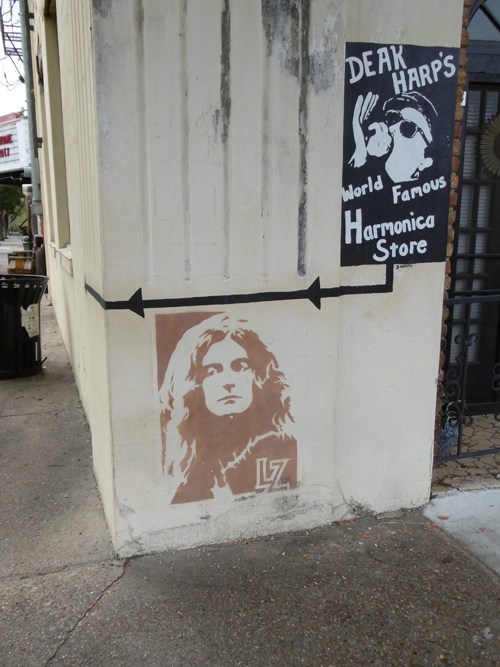
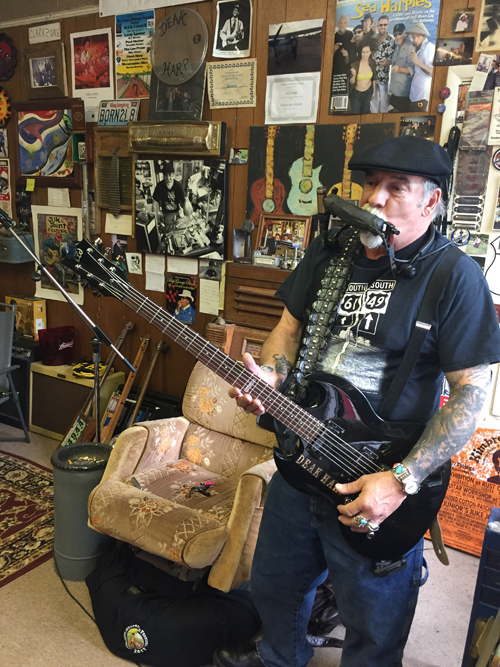
A couple of weeks later Robin was talking to harmonica player for a band he'd gone to see in London, and asked if he'd heard of Deak Harp: "Hell yes, he's one of the greats!" Maybe so, but he was very down to earth and patient with us. He showed and demoed a whole slew of different keys from a little squeaky thing that looked like it might have come out of a Christmas Cracker, to a bass model that was at least 18 inches across.
He showed us how he took apart a brand new $50 Hohner harmonica, "tuned it" gave it a beautiful red lacquer paint job to create a $250 Deak Harp Special. This made sense of the sign in his window: "Open Harp Surgery". It seemed like a bargain but was rightly a bit steep for Adam's very first instrument, so he helped Adam pick out a regular Hohner in the right key.
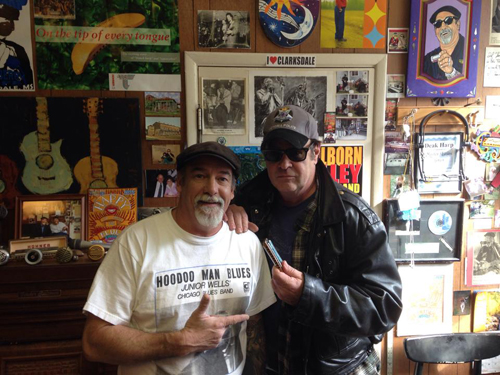 While I was researching Deak Harp I came across this great shot of him with The Blues Brother himself, Dan Aykroyd. Check out the similarity of the setting with our shot above, and the similarity of pose with our shot right. While I was researching Deak Harp I came across this great shot of him with The Blues Brother himself, Dan Aykroyd. Check out the similarity of the setting with our shot above, and the similarity of pose with our shot right.We bought CD's and he signed them all, and finally posed on the bench outside the shop for a portrait with Adam. A thoroughly entertaining half-hour. |
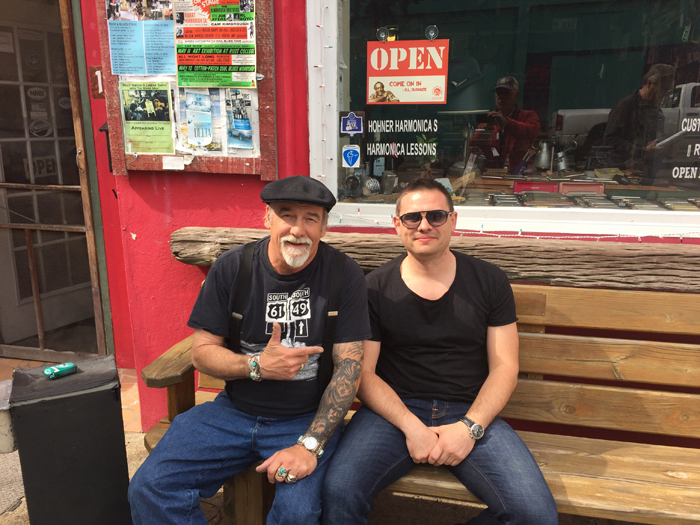 |
We made one more stop, at an artsy sort of store, but the only thing that caught our fancy was a map of Mississippi River wanderings over time, which looked like a tangle of colorful snakes weaving around each other. The owner and a couple he was talking to were trying to outdo each other in proofs of how important and well-connected they each were. We were ignored on our way in, and ignored on our way out. It did not spoil our day but it did provide an easy segue to return to the van and head north.
As advertized we headed north west out of town and after about half an hour came to the bridge. A bunch of people tried to take pictures, and even video, but it wasn't all that photogenic in the first place, and inside the bridge is a challenging place to view it from. But cross the Mississippi we did, and bagged Arkansas, a new state for all of us. No surprise, Arkansas comprised flat, featureless fields as far as the eye could see. The highlight was a pit stop for the van and for us. While I filled the tank, others went inside to let the lunchtime beer out, and to replace it with coffee. But of course the boys had to explore all the aisles and came back with pork crackling (scratchings) in several flavors no less, and the best of show by far, a paper cone full of deep-fried chicken livers. Crispy outside and that soft, sorta-smooth sorta-not-smooth texture that only liver has on the inside. Oh-My-God-delicious.
The rest of the trip was event-free. Eventually we crossed back over the river on the bridge by the hotel but we pressed on, setting our sights on the Germantown Commissary, our Monday night Uber recommendation. It was clear across the other side of town, and they didn't take reservations, but an adventure is an adventure.
Germantown Commissary
The Germantown Commissary, "so good y'ull slap yo' mama" was packed, of course, and we had about a 20 minute wait. It was an old wooden structure as you might expect of a building that was a small country store for over 90 years before being converted 35 years ago into "one of the best Memphis BBQ joints around." The entrance foyer still felt like a country store with counters and walls stacked with tchotchke and souvenirs. Having studied the menu three or four times, I asked a waitress what was Brunswick stew? "Hmm" she thought for a moment "It’s like a vegetable soup. With pork." Perfect, I'd expect nothing less from a self-respecting BBQ joint.
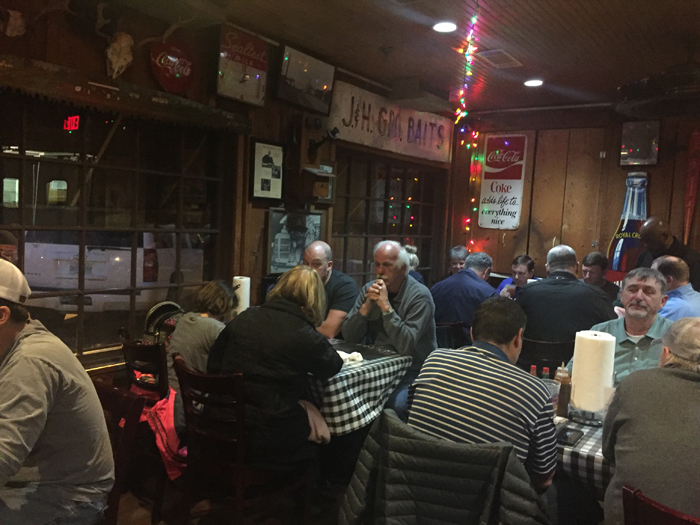 |
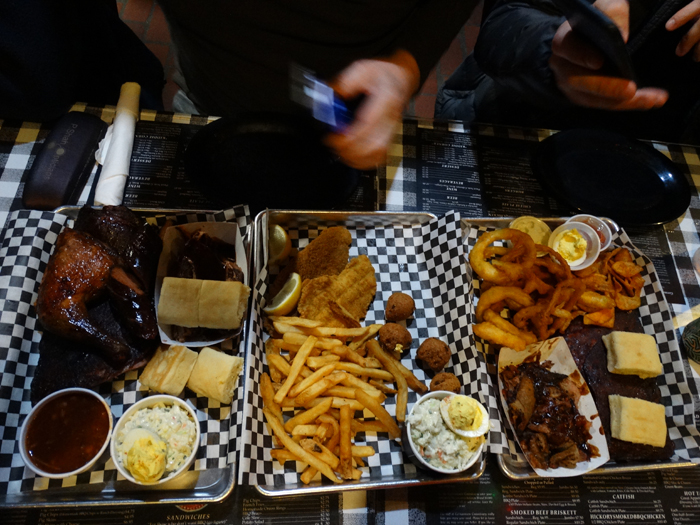 |
Soon enough we were up, and again took advice on what to order. Everything came with a deviled egg (house speciality), which explained the display of dozens of them in one of the foyer counters. Once again, what's to say about a bar-b-q dinner? The service was just okay, I hate eating with or off desposable serviceware, but none of that matters a hill of beans when there are beans. In addition to beans we had all the options: dry and wet ribs; fried chicken and onion rings; cole slaw and potato salad. Washed down with a couple of nondescript, but local, brews, and we did our level best to clear the table.
The Cove
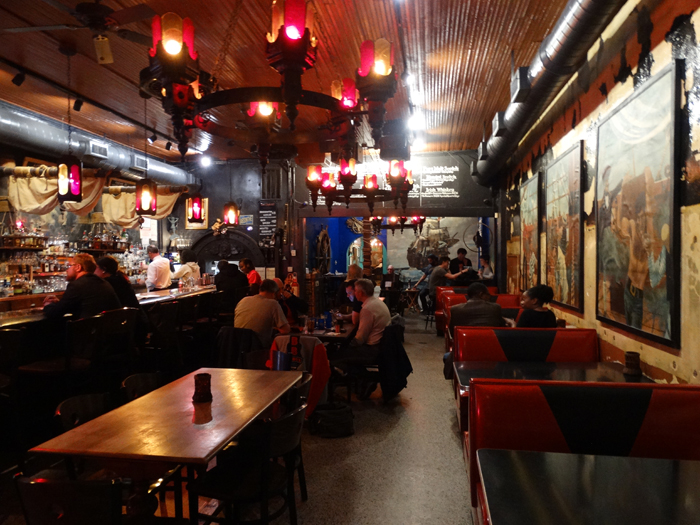
We returned to the hotel to drop off the van and take an Uber into town for the evening entertainment. We discussed our lack of plan with the Uber driver, and a desire to find a place where we might also be able enjoy a few drinks and conversation. "I know just the place, but it is a little out of town" Of course we agreed and approved his request to drive off the meter instead of resetting it. Now we were old friends I asked the driver what we were going to do if we didn't like the place. "Ok" he says "here's the deal. I guarantee you'll like it, but if you don't, call me and I'll take you back to town on my dime." "Are you serious? I'm sure that won't be necessary... but I guess you'd better give me your number just in case [Smiley Face]" He actually had cards, and he handed me one.
Apparently The Cove was in an up-and-coming part of town, but it still had a distinctly down-and-out vibe, and so there's no way we would have found this place on our own, or if we'd found it, we might not have slowed down. Excellent. In we went, armed with our money-back-guarantee. And of course it was an amazing place. "The Cove is a retro, nautical-themed bar and restaurant that is a resurrection of the type of dive that used to exist on every corner in New Orleans. The presence of the legendary Anderton's Restaurant Ship Bar, however, gives The Cove a flavor that is uniquely Memphis." And uniquely nautical, not to say pirate. But what got Adam's immediate attention was its reputation "for its meticulous preparation of cocktails." The space was extremely long and thin, with the bar section at the front with room for half a dozen tables in front of it, then a middle room/corridor and a larger dining room at the back that apparently also led out onto a patio. As usual, it looked like it could hold at least a hundred people, but tonight had a perfect dozen or so. A three-piece jazz ensemble was squeezed into the middle section playing discretely. It was loud enough for me to hear, but quiet enough not to annoy my not-quite-so-enthusiastic companions. No matter. There was amazing booze on tap. That's about it. We talked, we drank, I listened. Life is good. I called "our driver" and offered him the fare home if he was still out on the hunt. He was there in 5 minutes. It was nice to be able to thank him for the recommendation and give him another off-the-books fare. We crashed into our pillows. What a day.